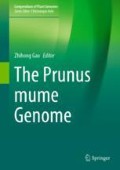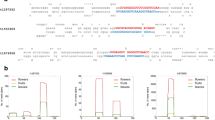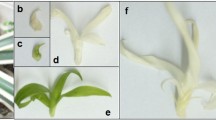Abstract
Japanese apricot (Prunus mume Sieb. et Zucc) is an important economic fruit crop in China and Japan, with more than 200 cultivars in China. It is one of the most valuable materials used in the food and winemaking industries and is believed to contain many physio-chemicals beneficial for human health. MicroRNAs (miRNAs) are a class of endogenous, small, noncoding RNAs that regulate gene expression by mediating gene silencing at transcriptional and post-transcriptional levels in higher plants. High-throughput sequencing is used to identify and quantitatively profile small RNAs in Japanese apricot. Previous studies have shown comparative identification of miRNAs between perfect and imperfect Japanese apricot flowers and some small RNAs related to the flower opening process.
Similar content being viewed by others
Keywords
8.1 Introduction
In the past, miRNA identification in flowers using sequencing approaches was commonly applied in studies of Arabidopsis (Yang et al. 2011), tomato (Wang et al. 2011b), orchid (An et al. 2011), Boechera (Amiteye et al. 2011), maize (Wang et al. 2011a), cotton (Pang et al. 2009), safflower and grape. Arabidopsis miRNAs (Rajagopalan et al. 2006) regulate multiple developmental events.
8.2 High-Throughput Sequencing of Small RNAs from Japanese Apricot Flower Bud Tissue
Taking a broader view of the high-throughput sequencing of small RNAs in Japanese apricot, it was observed that small RNAs of 24 nt dominated the library of unique species (Gao et al. 2012; Wang et al. 2014) (Fig. 8.1), as has been reported for many other plant species, such as Arabidopsis thaliana (Fahlgren et al. 2007), Citrus trifoliata (Song et al. 2010), Medicago truncatula, Citrus sativus and Citrus Sinensis (Xu et al. 2010). However, the most abundant small RNAs in the imperfect library were 21 nt long. Normally, the length of small RNAs is between 18 and 30 nt. Length distribution analysis is a helpful way to assess the composition of small RNA samples. For example, miRNA is normally 21 nt or 22 nt long, whereas siRNA is 24 nt long (Bartel 2004).
The overall distribution patterns of small RNAs (21-nt sRNAs = 30.33% and 24-nt sRNAs = 35.63%) in Japanese apricot are significantly different from that in Pinus contorta, a conifer species in which 21-nt RNAs are more abundant (>50%) and 24-nt RNAs are less frequent (2.5%). A striking difference also exists when comparing Japanese apricot small RNAs with monocot species of rice. When compared with eudicotyledon species of sweet orange, the difference is not that evident, but still exists, such that 24-nt sRNAs are most frequent (>50%), while 21-nt sRNAs are less common (<20%). These analyses indicate that the small RNA transcriptome is complex across plant species and can be significantly different between phylogenetically distant plant families.
The majority of known miRNA reads are 21–22-nt in length for both libraries (Fig. 8.2a), and the 21-nt sRNAs are the most abundant ones, which is similar to the results reported for Phalaenopsis orchid (An et al. 2011). The majority of known unique miRNA sequences are 21–24 nt in length for both libraries (Fig. 8.2b), and the 24-nt miRNAs are more abundant than the 21-nt miRNAs, which may be due to the important biological functions of 21- and 24-nt miRNAs during flower opening in P. mume.
8.3 miRNA Identification in Plant Flowers
In 2012, researchers identified 61 known miRNAs, belonging to 24 families (Fig. 8.3), and 61 potentially novel miRNAs/new members of known miRNA families (Gao et al. 2012). The analysis revealed that some miRNA families are expressed in the flowers of other plant species, but they are not flower specific. For example, miR156/miR157, miR166 and miR167 were represented most frequently in the libraries in this study. The involvement of three miRNA families (miR172, miR159/miR319 and miR156) in flowering-time regulation has recently been demonstrated in other investigations (Jones-Rhoades et al. 2006). Also, miR164, miR319, miR159 and miR167 specify particular cell types during the later stages of flower development (Nag and Jack 2010). Furthermore, the comparison of these species’ miRNAs showed that miR156/miR157 and miR172 might be components of a regulatory pathway mediating the transition between the vegetative and the reproductive phases in plants. In addition, miR172 regulates stem cell fate and defines the inner boundary of APETALA3 and PISTILLATA expression domains in Arabidopsis floral meristems (Zhao et al. 2007). By targeting APETALA2 and type III homeodomain-leucine zipper (HD-Zip) genes, miR166 regulates the temporal program of floral stem cells (Ji et al. 2011). It is believed that miR167, like miR160, targets mRNAs coding for ARF, which are DNA-binding proteins that are thought to control transcription in response to the phytohormone auxin. Transcriptional regulation is important for many of the diverse developmental responses to auxin signals, which include cell elongation, division and differentiation in both roots and shoots (Licausi et al. 2011).
8.4 Identification of Known miRNAs and Evolutionary Conservation
To investigate the evolutionary roles of these known miRNAs, extensive comparisons were performed against known miRNAs in other plant species, including Physcomitrella, Selaginella, Picea, Pinus, Arabidopsis, Brassica, Ricinus, Glycine, Medicago, Gossypium, Solanum, Aquilegia, Citrus, Populus, Vitis, Oryza, Sorghum and Zea (Fig. 8.4). Among the miRNA sequences obtained from Japanese apricot, members in five of the families (miR403, miR535, miR827, miR828 and miR2111) showed a lack of conservation of sequence identity compared to orthologues from 18 other plant species. Generally, Japanese apricot miRNAs had corresponding homologs in at least two plant species. Japanese apricot, Arabidopsis and Vitis vinifera shared 23 conserved miRNA families. Twelve (miR156, miR159, miR160, miR166, miR167, miR171, miR390, miR395, miR396, miR398, miR408 and miR535) out of 24 families had orthologues in Coniferophyta and Embryophyta, indicating that these 12 Japanese apricot miRNA families are ancient. Twelve (miR162, miR164, miR168, miR169, miR172, miR393, miR394, miR399, miR403, miR827, miR828 and miR2111) out of 24 families only had homologs in angiosperms, indicating that these 12 Japanese apricot miRNA families are recent. In addition, miR403, miR828 and miR2111 only had homologs in eudicotyledons, suggesting that these miRNAs are probably involved in the regulation of specific development.
Most of the conserved miRNAs in P. mume were identical to their reference miRNAs sequences, indicating that they are highly conserved among plant species. Sometimes, miRNA family members cluster at a proximal distance on a chromosome in the genome to coordinately express and regulate multiple processes in plants (Li and Mao 2007). Members of the miR395 gene family are clustered with various cluster sizes and intergenic distances in Arabidopsis (Maher 2006), Solanum demissum (Li and Mao 2007), rice (Guddeti et al. 2005), M. truncatula (Guddeti et al. 2005), Populus trichocarpa (Lu et al. 2005) and Brachypodium (Lu et al. 2005) genomes. Wang et al. (2014) identified ten precursors of the miR395 family that clustered together on scaffold28 in the draft P. mume genome (Fig. 8.5). The maximum distance between two of these family members was approximately 15,000 nt, while the shortest distance was 142 nt. The miR395 family in P. mume was predicted to target mRNAs for ATP sulfurylase and sulfate transporters, both of which are involved in the sulfate metabolism pathway, which is in agreement with results from Arabidopsis (Liang et al. 2010).
Genomic organization of the miR395 family in P. mume. Thin black line represents genomic DNA fragments of scaffold28. Solid vertical bars represent miR395a-j genes. The locations of miR395 genes are roughly in proportion to their real physical locations. Letters below the vertical bars indicate names of the genes. Asterisks denote miR395 genes whose miRNAs* have been detected in this study. Scale bar represents 15 kb
8.5 Identification and Expression of miRNA-Guided Cleavage of Target Genes in P. mume
Wang et al. (2014) have detected the cleavage sites in seven predicted target genes in P. mume (Fig. 8.5). Four SPL genes (Pm030597, Pm002693, Pm002694 and Pm024528), one ARF gene (Pm010467), one SCL gene (Pm017821) and one AP2 gene (Pm018608) were confirmed to be targets of the miR156, miR167, miR171 and miR172 families, respectively. Moreover, the detected cleavage sites in seven predicted target genes were mapped onto the paired miRNA at the tenth or eleventh nucleotide from the 5′ end (Fig. 8.6). Four of these targets, which were predicted to be SPL transcription factors, were regulated by miR156 in P. mume (Wang et al. 2014).
Detection of miRNA-mediated mRNA cleavage using modified 5′-RACE and comparative relative expression of targets between two developmental stages by qRT-PCR. The arrows indicate the 5′ cleavage sites that were sequenced from 5′-end cleavage products, which were identified from cloned 5′-RACE products, with the frequency of clones shown
Sequences analysis identified 92 conserved miRNAs and 33 novel miRNAs in P. mume. Differential expression analysis revealed 21 miRNA sequences during the process of P. mume flower opening. The results of qRT-PCR validated the expression of a series of conserved and novel miRNAs revealed by Solexa sequencing. Seven target genes were verified by 5′-RACE to be the targets of miR156, miR167, miR171 and miR172, respectively. These findings contribute to the identification of P. mume miRNAs and deepen our understanding of their roles in flower opening (Wang et al. 2014).
References
Amiteye S, Corral JM, Vogel H, Sharbel TF (2011) Analysis of conserved microRNAs in floral tissues of sexual and apomictic Boechera species. BMC Genom 12(1):500
An FM, Hsiao SR, Chan MT (2011). Sequencing-based approaches reveal low ambient temperature-responsive and tissue-specific microRNAs in Phalaenopsis Orchid (Research Support, Non-U.S. Govt). PLoS One 6(5):e18937
Bartel DP (2004) MicroRNAs: genomics, biogenesis, mechanism, and function. Cell 116(2):281–297
Fahlgren N, Howell MD, Kasschau KD, Chapman EJ, Sullivan CM, Cumbie JS et al (2007) High-throughput sequencing of Arabidopsis microRNAs: evidence for frequent birth and death of MIRNA genes. PLoS ONE 2(2):e219
Gao Z, Shi T, Luo X, Zhang Z, Zhuang W, Wang L (2012) High-throughput sequencing of small RNAs and analysis of differentially expressed microRNAs associated with pistil development in Japanese apricot. BMC Genom 13(1):371
Guddeti S, Zhang DC, Li AL, Leseberg CH, Kang H, Li XG et al (2005) Molecular evolution of the rice miR395 gene family. Cell Res 15(8):631–638
Ji L, Liu X, Yan J, Wang W, Yumul RE, Kim YJ et al (2011) ARGONAUTE10 and ARGONAUTE1 regulate the termination of floral stem cells through two microRNAs in Arabidopsis. PLoS Genet 7(3):e1001358
Jones-Rhoades MW, Bartel DP, Bartel B (2006) MicroRNAs and their regulatory roles in plants. Annu Rev Plant Biol 57:19–53
Li A, Mao L (2007) Evolution of plant microRNA gene families. Cell Res 17(3):212–218
Liang G, Yang F, Yu D (2010) MicroRNA395 mediates regulation of sulfate accumulation and allocation in Arabidopsis thaliana. Plant J 62(6):1046–1057
Licausi F, Weits DA, Pant BD, Scheible WR, Geigenberger P, van Dongen JT (2011) Hypoxia responsive gene expression is mediated by various subsets of transcription factors and miRNAs that are determined by the actual oxygen availability. New Phytol 190(2):442–456
Lu S, Sun Y-H, Shi R, Clark C, Li L, Chiang VL (2005) Novel and mechanical stress–responsive microRNAs in Populus trichocarpa that are absent from Arabidopsis. Plant Cell 17(8):2186–2203
Maher C (2006) Evolution of Arabidopsis microRNA families through duplication events. Genome Res 16(4):510–519
Nag A, Jack T (2010) Sculpting the flower; the role of microRNAs in flower development. Curr Top Dev Biol 91:349–378
Pang M, Woodward AW, Agarwal V, Guan X, Ha M, Ramachandran V et al (2009) Genome-wide analysis reveals rapid and dynamic changes in miRNA and siRNA sequence and expression during ovule and fiber development in allotetraploid cotton (Gossypium hirsutum L.). Genome. Biol 10(11):R122
Rajagopalan R, Vaucheret H, Trejo J, Bartel DP (2006) A diverse and evolutionarily fluid set of microRNAs in Arabidopsis thaliana. Genes Dev 20(24):3407–3425
Song C, Wang C, Zhang C, Korir NK, Yu H, Ma Z et al (2010) Deep sequencing discovery of novel and conserved microRNAs in trifoliate orange (Citrus trifoliata). BMC Genom 11(1):431
Wang L, Liu H, Li D, Chen H (2011a). Identification and characterization of maize microRNAs involved in the very early stage of seed germination (Research Support, Non-U.S. Gov’t). BMC Genomics 12:154
Wang Y, Itaya A, Zhong X, Wu Y, Zhang J, van der Knaap E et al (2011b) Function and evolution of a microRNA that regulates a Ca2±ATPase and triggers the formation of phased small interfering RNAs in tomato reproductive growth. Plant Cell Online 23(9):3185–3203
Wang T, Pan H, Wang J, Yang W, Cheng T, Zhang Q (2014) Identification and profiling of novel and conserved microRNAs during the flower opening process in Prunus mume via deep sequencing. Mol Genet Genomics 289(2):169–183
Xu MJ, Liu Q, Nisbet AJ, Cai XQ, Yan C, Lin RQ et al (2010) Identification and characterization of microRNAs in Clonorchis sinensis of human health significance. BMC Genom 11(1):521
Yang XZ, Zhang HY, Li L (2011) Global analysis of gene-level microRNA expression in Arabidopsis using deep sequencing data. Genomics 98(1):40–46
Zhao L, Kim Y, Dinh TT, Chen X (2007) miR172 regulates stem cell fate and defines the inner boundary of APETALA3 and PISTILLATA expression domain in Arabidopsis floral meristems. Plant J. 51(5):840–849
Author information
Authors and Affiliations
Corresponding author
Editor information
Editors and Affiliations
Rights and permissions
Copyright information
© 2019 Springer Nature Switzerland AG
About this chapter
Cite this chapter
Gao, Z., Shi, T. (2019). Small RNAs in Prunus mume. In: Gao, Z. (eds) The Prunus mume Genome. Compendium of Plant Genomes. Springer, Cham. https://doi.org/10.1007/978-3-030-10797-0_8
Download citation
DOI: https://doi.org/10.1007/978-3-030-10797-0_8
Published:
Publisher Name: Springer, Cham
Print ISBN: 978-3-030-10796-3
Online ISBN: 978-3-030-10797-0
eBook Packages: Biomedical and Life SciencesBiomedical and Life Sciences (R0)










